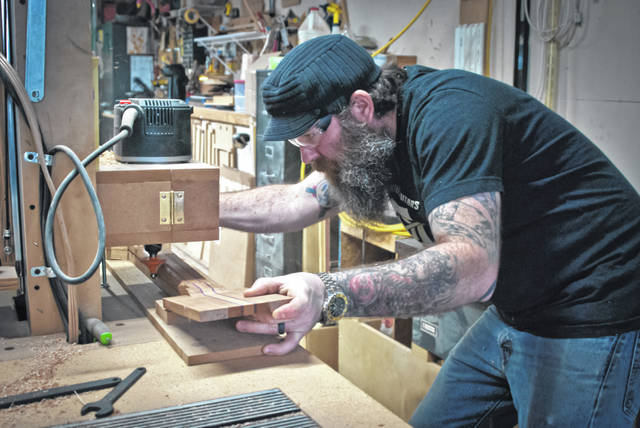
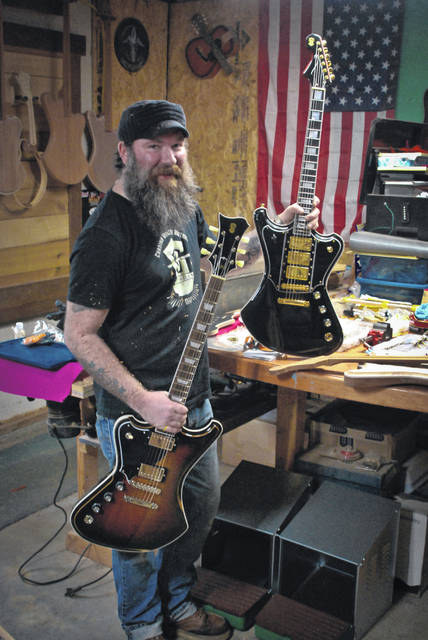
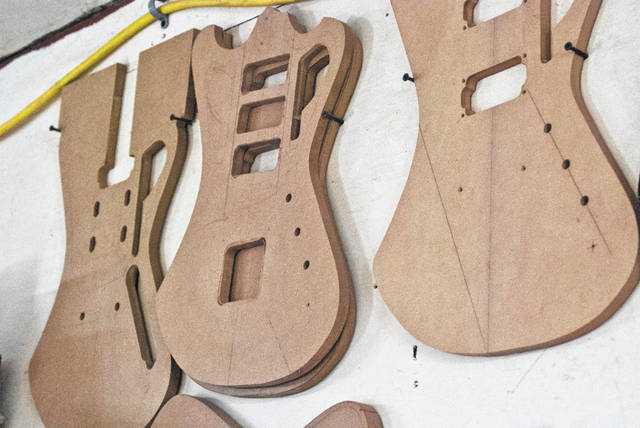
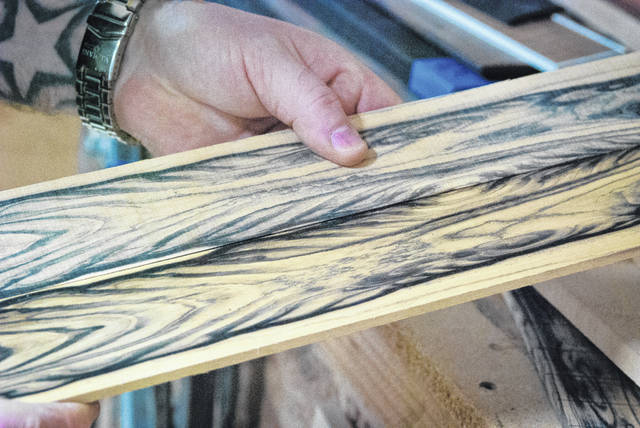
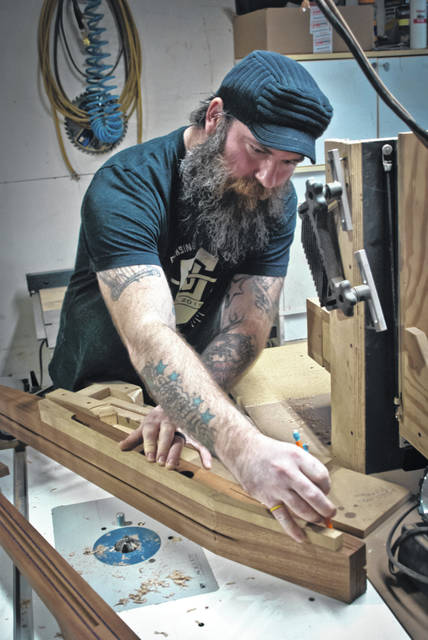
Chase Gullett’s vision isn’t just centered on building a custom design guitar business — he wants to create a Delaware area music community.
“The Delaware area has always had such a rich, ingrained music community,” he said. “It’s not about building a single business. It’s about growing a community — a music community.”
Gullett, a 20-year woodworking veteran turned traditional luthier, sold off his two hot rods and a vintage Gibson guitar in 2015 to invest in his dream — Chasing Vintage Guitars.
“Those were tough times just keeping the lights on,” he said.
Gullett is one of two certified Taylor Guitar craftsman in central Ohio, and one of 11 in the state. He currently builds his guitars in his small woodworking shop in Ostrander.
Gullett handpicks raw woods from the mill to create original, solid-body electric guitar designs using mahogany, purple heart, rosewood, ebony, curly maple, and abalone woods. He uses a variety of seashells, mother of pearl, and brass inlays to customize his custom-ordered works of craftsmanship and art.
“I work primarily in mahogany for the body of the guitars,” he said. “I use coarser woods for the necks, because they are more stable for the application.”
Gullett said some of his designs have included Viking ruins, constellations to create an interstellar look, a family’s zodiac signs, and LED lights running along the side of the fretboard to give the guitarist a quick, clear view on a dark stage.
“I didn’t want something blindingly bright, but if you’re on a dark stage, those LEDs are not crazy but perfect,” he said. “I didn’t want it to look like a parlor trick. It also gives the added benefit of seeing the fretboard on a dark stage, but then when they’re off, it looks very traditional.”
Gullett said since wood expands and contracts along the grain line, he orients it so the fretboard remains stable through humidity and temperature changes.
“There’s a lot of real science and practical applications behind this stuff that not everybody understands,” he said. “I think that is one of the unique things as a builder that sets you apart if you’re building from scratch.”
Gullett said he started playing guitar when he was 15 years old on a guitar from the pawn shop. He leaned toward guitars mostly because of his father’s influence of listening to rock and roll music.
“Growing up, my dad was like a rock and roller type of guy,” Gullett said. “You know, smokin’ them left-handed cigarettes and playing that rock and roll music.”
Gullett said he played in various bands in high school and while in his 20s, but now he wants to give others a chance to experience playing the music that moves them. He said in recent years, there has been a lag in the music community due to the tech age, but he wants to try to get it started again.
“I want to revitalize the music community,” he said. “Kids dropped out of hobbies in the recent technology age. They have been playing with cell phones since they were four and have become bored with them. They’re now reaching for guitars and learning to play again.”
Gullett added there is a catch-22 to the revitalization, however. He said on average, there are two million guitars sold every year with a majority of the purchases coming from online factory dealers.
“Unless it is a professional model instrument, it has not been set up or dialed in,” he said. “You get this guitar that’s a hunk of crap, because it didn’t get the care it needed when it went out. It’s not set up right, and the beginner guitars are the worst.”
Gullett said kids get excited, take guitar lessons, practice chords and finger positions only to become discouraged at the fact the sound is horrible, because the guitar came as is and not what he calls “dialed in.”
“They get frustrated, because it doesn’t sound good,” he said. “It just doesn’t help anyone wanting to learn to carry forward with lessons.”
Gullett said before the internet, music stores took an instrument to the backroom to be set up before it was put on the showroom floor or into the hands of a customer.
“They dialed everything in,” he said. “We’re trying to help build a community and culture by giving them the best tools to make the best music.”
Gullett wants to include everyone, so he’s designed guitars for the traditional right-hand player and the “southpaw” left-hand player as well.
“The southpaw guys are the devil-handed gentlemen,” he said with a grin. “There’s not a lot of guys out there building left-hand instruments, especially in the boutique market. I’m trying to give more access to more artists, basically.”
Jay Shuter, a client and a friend of Gullett, agrees that the Delaware area is an art community.
“I think Chase hit it right on the spot, because Delaware does have sort of a great arts community in general,” he said. “Delaware is just growing, and it’s got sort of its own personality. There is definitely a spot that needs to be filled by something like a specialized guitar shop.”
Shuter said he has bought his share of poorly sounding guitars from online shops.
“My experience here is you’re only as good as the tools you work with,” he said.
Gullett said his business has doubled every year, but he has reached his saturation point of building 25 guitars a year. He said people don’t want to buy a guitar built by someone he had supervised.
“Beyond the Chasing Vintage Guitar’s aspect, I’m launching Gullett Guitar Service this year,” he said. “Basically, I’m going to be the only repair and maintenance shop north of I-270.”
Gullett said he currently does guitar repair, but it has been more word of mouth among the local musicians.
“Local musicians were like, ‘Hey man, do you work on guitars?’ I’d say, ‘Yeah, sure,” Gullett said. “I don’t know which is more important. The service or building the guitars. One lets me be international, and the other lets me be local.”






